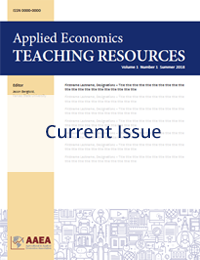Case Study
Adopting Precision Input Management: A Teaching Case Study
Cheryl Wachenheim(a), Erik Hanson(a)
(a)North Dakota State University
JEL Codes: JEL Codes: D14, Q12
Keywords: Case study, exercise, partial budgeting, precision agriculture
First Published Online: January 20, 2024
View Full Article (PDF) | Request Teaching Notes/Supplemental Materials
Abstract
Students are introduced to a framework for individual-farmer evaluation of the net benefits of adopting precision agricultural technologies (PATs). A young farmer is considering whether to use a PAT bundle. He is advised by a crop consultant. Students adopting the role of the farmer should analyze the basic economics associated with using the PAT. The focus is on identifying what differs from traditional application and that under PAT, finding information necessary to analyze the net effect, conducting sensitivity analysis, and factoring in qualitative considerations. Students should use partial budgeting analysis to calculate net change in profits expected from adopting a single PAT bundle.
References
Articles in this issue
Equity and Inclusion as Cornerstones for Building Academic Programs in Agricultural and Applied Economics
Kenrett Jefferson-Moore, Lurleen Walters, and Del Ruff
Are We Similar? Differences in Grading Patterns among Departments in the Same College
Anna Yeritsyan and James W. Mjelde
A Brief History of Giffen Behavior and an Applicable Student Example
Mark Holmgren
Benefit-Cost Analysis Decision Criteria: Reconciling Conflicting Advice
David J. Pannell, Hoa-Thi-Minh Nguyen, Hoang Long Chu, Tom Kompas, Abbie Rogers
Adopting Precision Input Management: A Teaching Case Study
Cheryl Wachenheim, Erik Hanson
Market Power in the U.S. Beef Packing Industry
Yuliya V. Bolotova
Mountain States Oilseeds: Can Contracts Enhance Safflower Seed Procurement?
Jameson Packer, Tanner McCarty, and Ryan Feuz
We Need to Talk About Curriculum Innovation
Roger Brown, Jennifer Clark, Rachna Tewari


